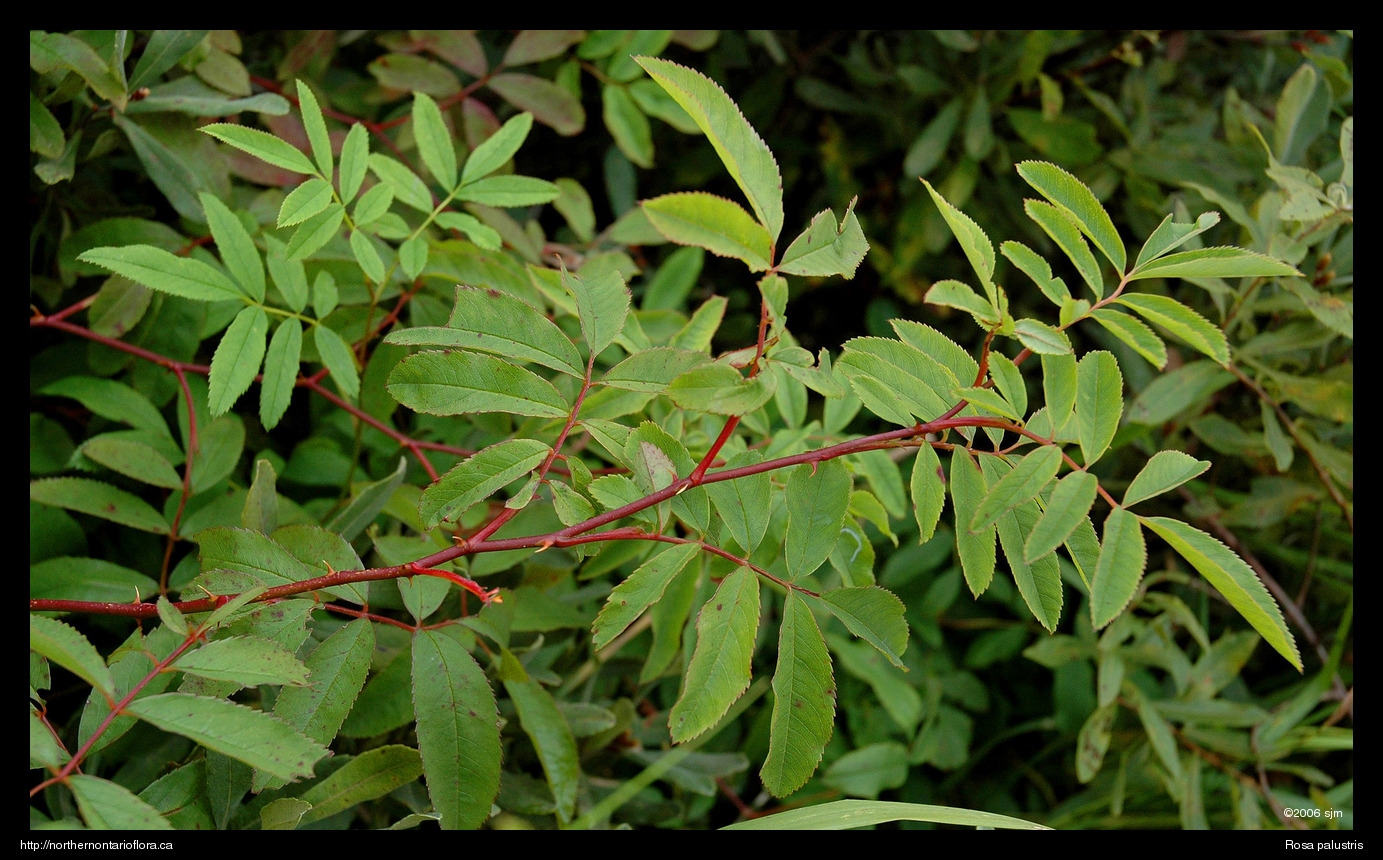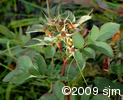
|
Northern Ontario Plant Database 
Plant DescriptionRosa palustris MarshallEn: swamp rose
Rosaceae (Rose Family) General: A perennial, branched, deciduous shrub to 2.5 m tall. Young stems are armed with a pair of broad-based recurved prickles, 2-8 mm long, situated at the nodes just below the leaf attachment; internodes are smooth (glabrous). Lower portions of older stems bear broad-based prickles to 1 cm long. Leaves: Alternate, pinnately compound, with a pair of narrow stipules, 0.5-3 mm wide, fused to the base of the petiole for about 1-2.5 cm, ending in short, divergent, triangular tips; stipule margins entire, sparingly or not glandular. Leaflets usually 7 (sometimes 5-9), elliptic to obovate, 2-6 cm long, dull and glabrous above, paler and finely hairy beneath; apex pointed (acute), to blunt (obtuse) or rounded; base obtuse to tapering (cuneate) to the petiole, margins toothed (serrate) to about the middle of the leaflet or nearly to the base. The terminal leaflet is stalked, while the lateral pairs of leaflets are sessile or very short-stalked. The leaf rachis bears scattered short prickles along the lower surface. Flowers: Bisexual, solitary or in few-flowered clusters; each flower 4-5.5 cm across. The base, or receptacle, of the flower forms a cup-shaped hypanthium, with the calyx lobes and petals attached to the rim of the hypanthium. The upper flower stalk (peduncle), hypanthium, and lower surface of the calyx lobes bearing conspicuous stalked, glandular hairs. The five calyx lobes are lanceolate with gradually tapering long narrow tips. The five petals are pink and obcordate. Stamens and pistils are numerous; the numerous superior ovaries are contained within the hypanthium, but the short styles are densely clustered at the top of the hypanthium, forming a round 'brush' at the centre of the flower. Flowers bloom in mid summer. Fruit: A fleshy, reddish-orange, globose hip, 0.6-1 cm in diameter, covered with stalked glandular hairs and containing numerous small achenes; 2.5-3.5 mm long. The calyx lobes spread outward in fruit. Rose hips have a high Vitamin C content and may be used dried to make teas or fresh to make jellies. Fruits mature in late summer to early autumn. Habitat and Range: Marshes, swamps, and shorelines. The swamp rose is native to eastern North America, with a range extending west from Nova Scotia to the eastern shores of Lake Superior. It has the most restricted range of the three most common rose species (Rosa acicularis, R. blanda, and R. palustris) in northern Ontario. While the swamp rose is found throughout southern and eastern Ontario, in northern Ontario it occurs only in the southern portions of Algoma District, extending northeast to Lake Timagami, around 47° N (Soper and Heimburger 1982). Internet Images: The swamp rose webpage from Will Cook's Trees, Shrubs, and Woody Vines of North Carolina website, Duke University, North Carolina. The Similar Species: Rosa blanda, the smooth or early wild rose, is found in drier habitats, such as fields, open woods, and clearings. Its upper branches are usually smooth or bear just a few scattered prickles, but the bases of older stems are often armed with several straight prickles. The Rosa blanda webpage is from the Shrubs of Wisconsin website. Rosa acicularis, the prickly wild rose, is common in rocky or sandy shores and open woods. Its stems are armed with numerous bristles and straight prickles. Rosa acicularis has a smooth, ovoid, reddish-orange fruit. Additional links: Back to species list |
||||||||||||||||||||||










